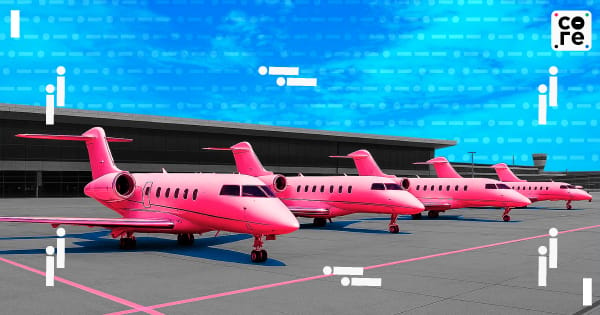- The Core
- Posts
- Private Aviation Is Hitting A Wall
Private Aviation Is Hitting A Wall
Good Morning. When we think of private jets or chartered flights, we immediately imagine swanky cabins and champagne flutes. While they exist, there are other, more practical private aviation aircraft that serve everyone from celebrities, politicians, to corporate executives. Private jets are often equated with luxury and excess, but they also form a crucial part of economic connectivity. And the demand for this is rising even though India’s infrastructure for this sector hasn’t kept up with increasing demand.
India’s equity indices fell for a third straight session on Tuesday. The BSE Sensex closed at 84,900.71, losing 331.21 points or 0.39%. The NSE Nifty50 closed at 25,959.5, 108.65 points or 0.42% lower.
In other news, India’s Russian oil imports are expected to drop sharply amid sanctions. Meanwhile, in this week’s Build On Blockchain, how blockchain can strike a balance between privacy and transparency in supply chains.
DECODE THE NEWS
India’s Private Aviation Boom Outpaces The Sector’s Infrastructure
What?
Udaipur has long hosted high-profile weddings, and this November, the Maharana Pratap Airport yet again saw a busy few days thanks to the Mantena-Gadiraju wedding, a high-profile celebration by two prominent business families that has gone viral on social media.
More than a hundred private jets and charters streamed into the airport as guests like Donald Trump Jr, Jennifer Lopez, Justin Bieber, Tiësto, Black Coffee, Cirque du Soleil performers, and a constellation of Bollywood stars landed in the city, turning the airport into a round-the-clock VIP operation.
It was a peek inside a sector that usually operates out of sight: India’s fast-growing private aviation industry, where the movement of the wealthy fuels economic activity far beyond airport gates.
Private aviation in India is expanding faster than the infrastructure, policies, and public perceptions surrounding it. As India becomes wealthier, business aviation is becoming an essential, but still misunderstood, layer of connectivity that can’t be ignored.
Why?
India has over 550 private aircraft, including jets, turboprops, and helicopters, making it South Asia’s largest general aviation market. Business aviation accounts for roughly 8-10% of India’s aviation sector, valued at $14.78 billion in 2025.
From December to March, weddings, corporate summits, cricket fixtures, and UDAN flights have operator schedules packed. For high-net-worth individuals such as celebrities and corporations, private jets are less about indulgence and more about speedy business and individual travel.
However, despite its booming economy and 13,300 ultra-high-net-worth individuals, India’s private aviation fleet remains modest. The sector continues to battle the perception that private jets are a symbol of indulgence and not infrastructure for productivity and connectivity.
Dismissed as luxury, business aviation faces neglect, scepticism, and lost strategic value.
“Sadly, Viksit Bharat 2047 offers no dedicated roadmap for business aviation infrastructure,” Rohit Kapur, founder of The Jet Company, told The Core.
Despite strong demand, India’s business aviation growth remains shackled by chronic challenges such as bureaucratic friction, fragmented regulation, limited and expensive parking bays, high import duties, and sluggish infrastructure.
Congested metros choke apron space in airports, and a weak domestic MRO ecosystem forces operators to fly aircraft abroad for heavy checks — costing operators time and money.
BUILD ON BLOCKCHAIN
Blockchain Can Show What Happened To A Product Without Exposing Who Did It
What?
When we buy a bar of chocolate, we check the wrapper and the manufacturing and expiry dates. The problem is that it’s easy to fudge these things.
For a customer to know whether it is genuine and made with the right ingredients, all the parties handling the supply chain should disclose what happened at their end.
So how do you strike a balance between privacy concerns and the need for openness?
In a recent conversation with The Core, Nikhil Varma of Algorand made a crucial point about the supply chain.
He said the supply chain becomes unreliable not because people hide everything, but because they are scared of sharing the wrong things. Everyone holds onto personal or sensitive information, so even basic facts get lost.
Varma’s point is that transparency is more about proving what happened rather than exposing people or compromising their trade secrets.
Why It Matters
That doesn’t mean we forget privacy. You don’t need the farmer’s name to check if the soil was healthy. You don’t need the factory worker’s identity to confirm the cooling machine worked. You don’t need the driver’s details to prove the truck arrived on time.
You need information about the product, not the person.
This is why privacy laws and transparency requirements are not adversaries. They’re actually trying to fix the same thing: unnecessary exposure.
Privacy keeps people safe, while transparency helps establish a product’s authenticity or the lack of it.
So how do we balance the two?
This series is brought to you in partnership with Algorand India.
Join The Core at the 2025 Algorand India Summit in Bengaluru on December 6-7. Register today to discover how blockchain technology is helping transform access to finance. Register here.
CORE NUMBER
$4 trillion
That’s the size India’s economy is set to cross this fiscal, according to Chief Economic Advisor V Anantha Nageswaran, reported PTI.
Context: India’s GDP was $3.9 trillion at the end of March 2025. Nageswaran said that strong and sustained growth is essential for India’s global standing, especially with geopolitics in a “huge state of flux.”
Why it matters: Crossing the $4 trillion threshold reinforces India’s position as one of the major economies in the world. India is currently the fifth-largest.
What Next? "Dealing with climate change and climate volatility have to be aligned with our priorities, both in the near term and the medium term," he said.
MESSAGE FROM OUR SPONSOR
7 Ways to Take Control of Your Legacy
Planning your estate might not sound like the most exciting thing on your to-do list, but trust us, it’s worth it. And with The Investor’s Guide to Estate Planning, preparing isn’t as daunting as it may seem.
Inside, you’ll find {straightforward advice} on tackling key documents to clearly spell out your wishes.
Plus, there’s help for having those all-important family conversations about your financial legacy to make sure everyone’s on the same page (and avoid negative future surprises).
Why leave things to chance when you can take control? Explore ways to start, review or refine your estate plan today with The Investor’s Guide to Estate Planning.
FROM THE PERIPHERY
India Cuts Russian Oil
India’s imports of Russian oil are set to fall in December to their lowest level in at least three years, dropping sharply from November highs as refiners shift to alternative supplies to avoid violating tightened Western sanctions, Reuters reported, citing trade and refining sources. The US, EU and UK have increased restrictions on Moscow, with Washington’s latest measures targeting Rosneft and Lukoil.
Why It Matters: Indian refiners are now more cautious due to increased bank scrutiny, with December inflows expected at 600,000-650,000 barrels per day, down from about 1.87 million bpd this month, provisional data shows. Most refiners have halted Russian purchases, while Reliance and Nayara are taking limited pre-committed cargoes. Meanwhile, India is boosting US oil imports as trade pressure builds.
Backstory: Buyers were given until November 21 to wind down dealings, while the EU will ban fuel from refineries processing Russian crude within 60 days after January 21.
DGCA Tightens Fatigue Rules
The Directorate General of Civil Aviation (DGCA) has issued fresh instructions to help airlines better manage crew fatigue. The regulator has mandated that all airlines provide at least one hour of annual training on how tiredness impacts pilots and cabin crew. This will be part of regular ground training.
Fast Facts: The move follows meetings with airlines and pilot unions, following DGCA's recent approval of more night landings and longer duty hours for some Boeing 787 flights. Last month, the DGCA had extended pilots’ duty hours by up to an hour — a small tweak that pilots warn could endanger safety. The All India Pilots Association (ALPA India) urged the DGCA to withdraw the flight duty time extension, calling it a direct threat to flight safety.
Fast Facts: Airlines must create a fatigue-reporting policy, form independent review committees, file quarterly reports with DGCA, and grant at least 24 hours of rest, including one night, when fatigue leave is taken. The yearly module must explain rules on flying and duty hours, sleep science, body-clock disruption, health-related fatigue, and how tiredness affects performance.
Steel Tariff Extension
India is considering extending a safeguard duty on select steel imports to counter cheaper shipments, particularly from China, Reuters reported citing sources. The Directorate General of Trade Remedies previously recommended an 11–12% levy for three years, following a temporary 12% tariff imposed in April that expired earlier this month. The Ministry of Finance has not yet commented on whether it plans to reinstate the duty.
Context: Despite the lapse, India’s finished steel imports fell 34.1% year-on-year in the first seven months of the financial year. South Korea was the top exporter during the period with 1.4 million metric tons, followed by China, Japan and Russia. However, sources said Chinese supplies still pose a risk due to lower prices.
Setting: China’s steel industry is meanwhile tightening output, with production expected to drop below 1 billion tons for the first time in six years. Beijing has also proposed stricter capacity swap rules to accelerate efforts to reduce overcapacity.
PODCASTS
On Episode 735 of The Core Report, financial journalist Govindraj Ethiraj talks to Sajjid Chinoy, Part-Time Member, EAC-PM (Economic Advisory Council to Prime Minister) & Chief India Economist & Head of Asia Economics at JPMorgan, as well as Manish Garg, CEO of Interarch Building Solutions Limited.
A new battle between Google and Nvidia and why it affects us.
The shocking story about Taiwan’s chip boom.
Can oil really fall to $30 a barrel, as JP Morgan says.
India’s Q2 GDP growth could come in at 7.2%
Steel prices are high because of import duties. Does it affect all downstream steel users?
THE TEAM
✍️ Zinal Dedhia, Kudrat Wadhwa, Shubhangi Bhatia | ✂️ Rohini Chatterji | 🎧 Joshua Thomas
🤝 Reach 80k+ CXOs? Partner with us.
✉️ Got questions or feedback? Reach out.
💰 Like The Core? Support us.



